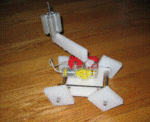A new method of locomotion has recently been invented that may prove useful in many scales of operation. While the title suggests a very narrow topic, there are in fact many interesting variations that arose during the development of this patent pending device. The application of which include robots, micro machines, novelty toys, and others. Troy, N.Y. (PRWEB) December 2, 2005 -- A new method of locomotion has recently been invented that may prove useful in many scales of operation. While the title suggests a very narrow topic, there are in fact many interesting variations that arose during the development of this patent pending device. The application of which include robots, micro machines, novelty toys, and others.
The first prototype consisted of a car with 4 square wheels, in the general configuration of a typical car, with all 4 wheels mechanically connected together so they must all turn in unison. Furthermore, the rotational orientation of the wheels are sequentially off-set from one wheel to the next by 22.5° (¼ of 90°), moving around the vehicle in a CW or CCW direction as viewed from above.
“The weight shifting that propels the car is facilitated by a weight offset laterally from the center of the car that is moved in a rotational manner around the center of the car”, says inventor Jason Winckler of Global Composites. “The rotation is provided by a driven shaft extending vertically from the center of the car, with a lateral arm and off-set weight. As the shaft rotates, the weigh shifts in a circular manner around the car”.
“The shifting weight sequentially drives each wheel that is under the weight to sit flat on the ground, thus moving the other wheels in a rotational manner, and the car in a linear direction; reversing the direction of the rotating weight, reverses the direction of the car. There are also several methods for steering the car that are under development” says Steven Winckler, President of Global Composites.
“For use in micro-machines or MEMS applications, one of the key benefits is that the motor and gearing moving the shifting weight is all in a plane parallel to the motion surface. No right angle gearboxes are required. The connection between the two axels can be accomplished by simple linkages” states Stephen Derby, President of Distributed Robotics LLC and consultant to Global Composites.
The main driving force for the table top prototype is produced by gravity pulling downward. Other forces that could hold the car against a surface, and provide the moving force necessary to increment the car along, include aerodynamic, hydrodynamic, magnetic, electromagnetic, and electrostatic. Such forces could be independent of the car mass, and could thus propel the vehicle with much greater force and velocity. In some instances, these forces could provide their own means to move from wheel to wheel, eliminating the central motor used in the prototype.
Global Composites is currently in early discussions with several companies for the licensing of this technology and will be exploring other markets.
For more information and a video demonstration on the square wheel car visit http://www.globalcomposites.net
For more information and a video demonstration on Distributed Robotics visit http://www.distributedrobotics.com
About Global Composites, Inc.
Global Composites, Inc. was started in 1999 as a spin-off from General Composites, Inc. to focus on design and process development of composite material products as well as research into other engineering challenges.
Contact: Steven Winckler (518) 339-3952
About Distributed Robotics LLC
Distributed Robotics was formed in 1998 to develop and market novel automation solutions for industry, ranging from full size machines to robotic end effectors for micro assembly.
Contact: Stephen Derby (518) 441-6101.
### | 










0 observations:
Publicar un comentario